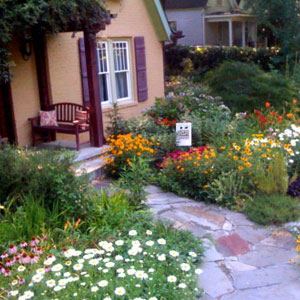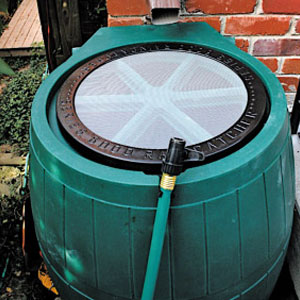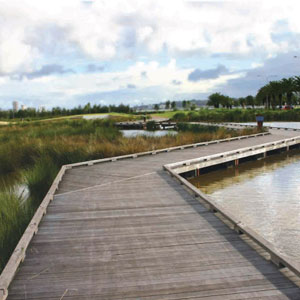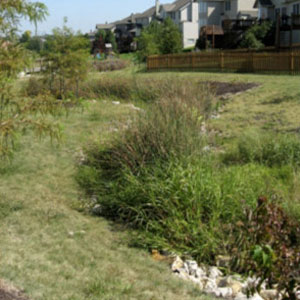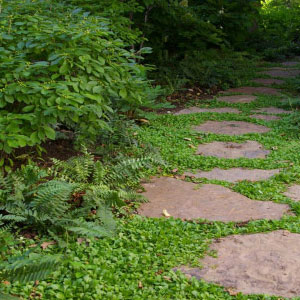Learning specific water reuse and conservation strategies, gardeners can utilize stormwater and other non-potable water sources (e.g., air conditioner condensate) to irrigate their garden or landscape. Sustainable gardens capture these resources, store them on-site and reuse them in the landscape. Doing so saves money and protects nearby ecosystems from harmful pollutants. In addition, the amount of water going to storm sewer systems is reduced, lessening the likelihood of flooding and combined sewer overflows.

This water feature conserves rainwater. As water runs off the roof, it moves through a gravel bioswale into a small pond. Stepping stones and porous pavers reduce the area of impervious surface and slow runoff. Image credit: SWT Design
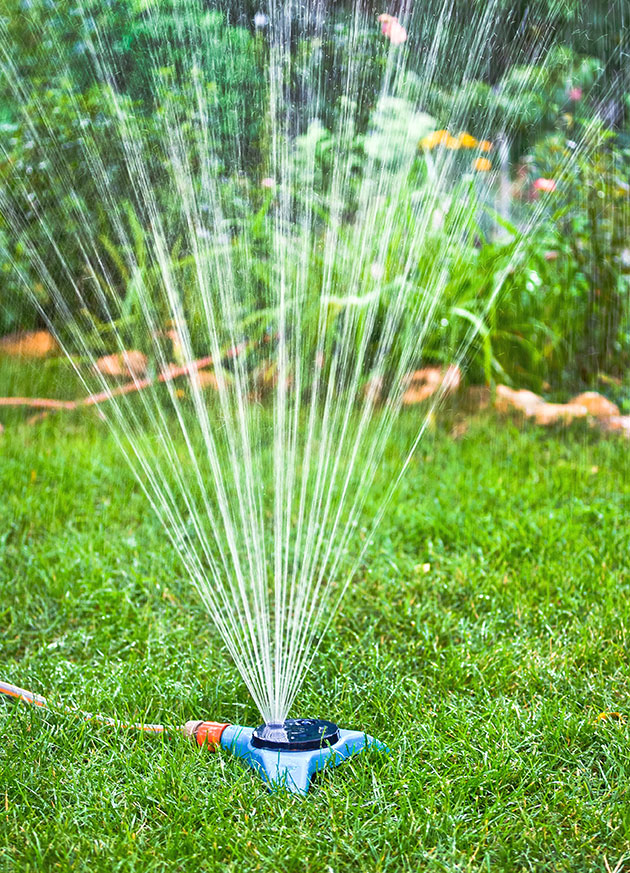
Lawns are unsustainable water hogs and sprinklers like this one waste water. Drip irrigation and diverse plantings are more sustainable options. Image credit: Shutterstock/Repina Valeriya
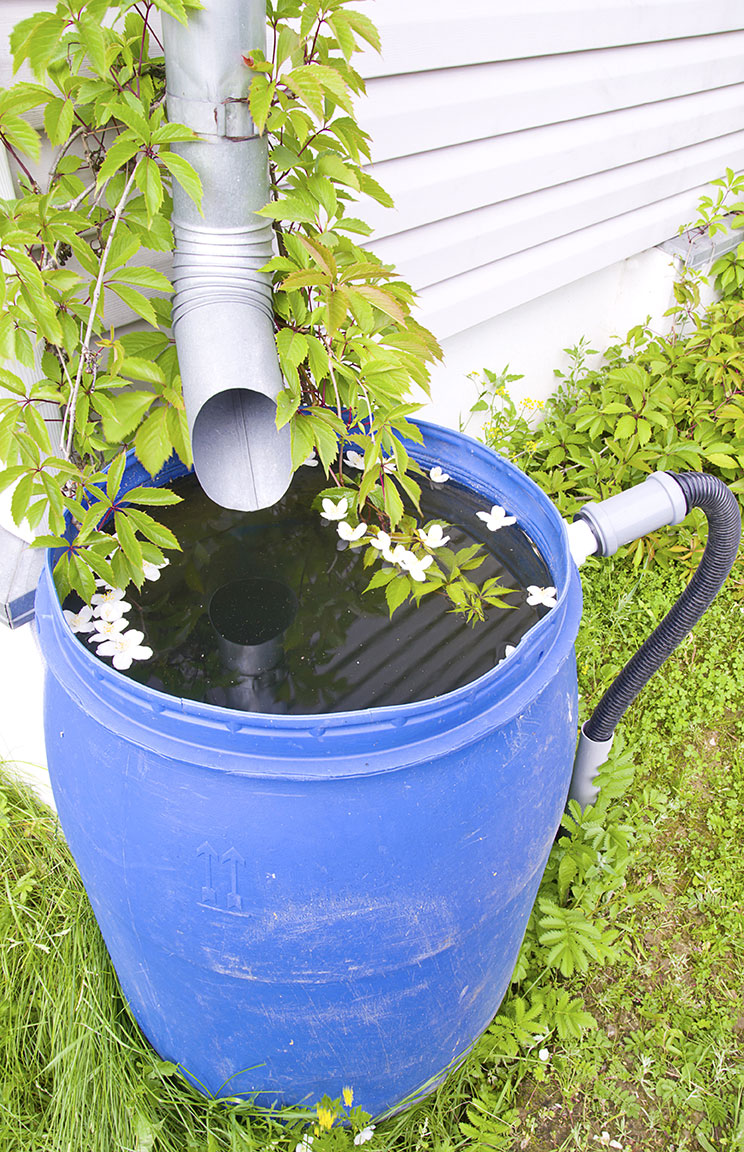
Rainwater captured in a plastic barrel. Image credit: Shutterstock/Egorov Igor
- Conserving water reduces cost for irrigation.
- Storing stormwater reduces runoff and lessens the amount of water that contributes to flooding.
- Reusing captured stormwater reduces the need for irrigation via potable water.
- Harvesting water from non-potable sources like air conditioner condensate or greywater minimizes dependency on potable water use.
Additionally, water in a landscape can provide opportunities for restorative experiences and reflection. Such activities may promote healing, stress reduction and work productivity. The benefits people derive from having a stronger physical and mental connection to water and its sources are innumerable.
Water use is also apparent in many of our local community resources, such as fire-fighting, maintaining local parks or filling municipal swimming pools. However, communities all across the country are starting to face challenges regarding the supply and availability of water for these local services.
Using water wisely and efficiently, as well as planning creative and restorative uses for water in the landscape, will address the importance of restoring and maintaining natural water sources and systems, and will allow people to have a stronger mental and physical connection to water and the local climate.

The sights and sounds of water features in a garden can reduce stress. Image credit: Shutterstock/Moomusician
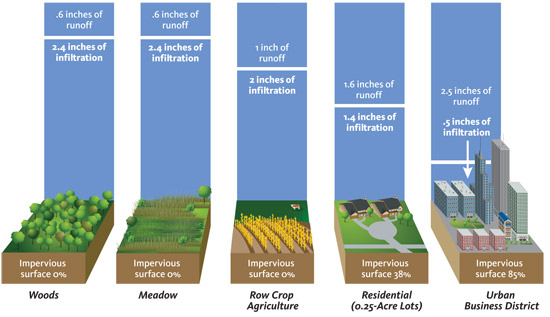
The infiltration and runoff of rainwater is directly influenced by the amount of impervious surface in an area. Image credit: Landscape For Life

Animal waste contributes to water pollution and must be disposed of properly. Image credit: Shutterstock/kkkomgri

Driveways covered with materials such as crushed seashells or locally sourced gravel are far more sustainable than those topped with coal tar sealants. Image credit: Shutterstock/jocic
Common sources of stormwater pollution:
Fertilizers, Herbicides and Insecticides
Excess nutrients from overuse of fertilizer can cause algal blooms when fertilizer runs off as part of stormwater. When algae die, they sink to the bottom and decompose in a process that removes oxygen from the water. Fish and other aquatic organisms can’t exist in water with low dissolved-oxygen levels. Insecticides and herbicides present in stormwater can poison aquatic life, while land animals and people can become sick from eating contaminated fish and shellfish or drinking pesticide-contaminated water. Homeowners can reduce the risk of these pollutants by minimizing their use of fertilizers and pesticides. Any excess fertilizer spread on driveways, sidewalks, streets or other impervious surfaces should be collected and properly disposed of before it has an opportunity to pollute stormwater.
Animal Waste
Rock Salt
Rock salt can leach into soil, changing its chemical composition, and it can poison fish and aquatic organisms after flowing into local waterways as part of stormwater runoff. It is also harmful to sensitive plants. Salt is highly corrosive to paved surfaces, buildings and metal. Alternatives to rock salt include materials that increase traction, such as kitty litter and sand. For situations where a product that actually melts ice is required, look for rock salt substitutes such as those made with beet juice extracts, a byproduct of beet sugar production that would normally be disposed of as waste. Magnesium chloride, which is safer to use near plants than rock salt (but not as effective in very cold conditions) is another possibility.
Fluids From Automobiles
Sediment
Building Materials
Coal Tar Sealants
Freshwater supports our environment and sustains our lives. It is essential to human survival, our livelihoods and almost every form of economic production. This finite resource is required for producing food, clothing and electronics; transporting waste; and supporting the natural environment.
These landscape practices contribute to freshwater shortages:
- Planting species not suited to local rainfall patterns
- Wasteful irrigation practices
- Degraded soil conditions that limit the infiltration and water-holding capacity of the soil
- Paving, roofing and other impervious surfaces that prevent water from infiltrating the soil and recharging groundwater supplies
- Treating stormwater as waste and funneling it to sewers before it has an opportunity to benefit the landscape.
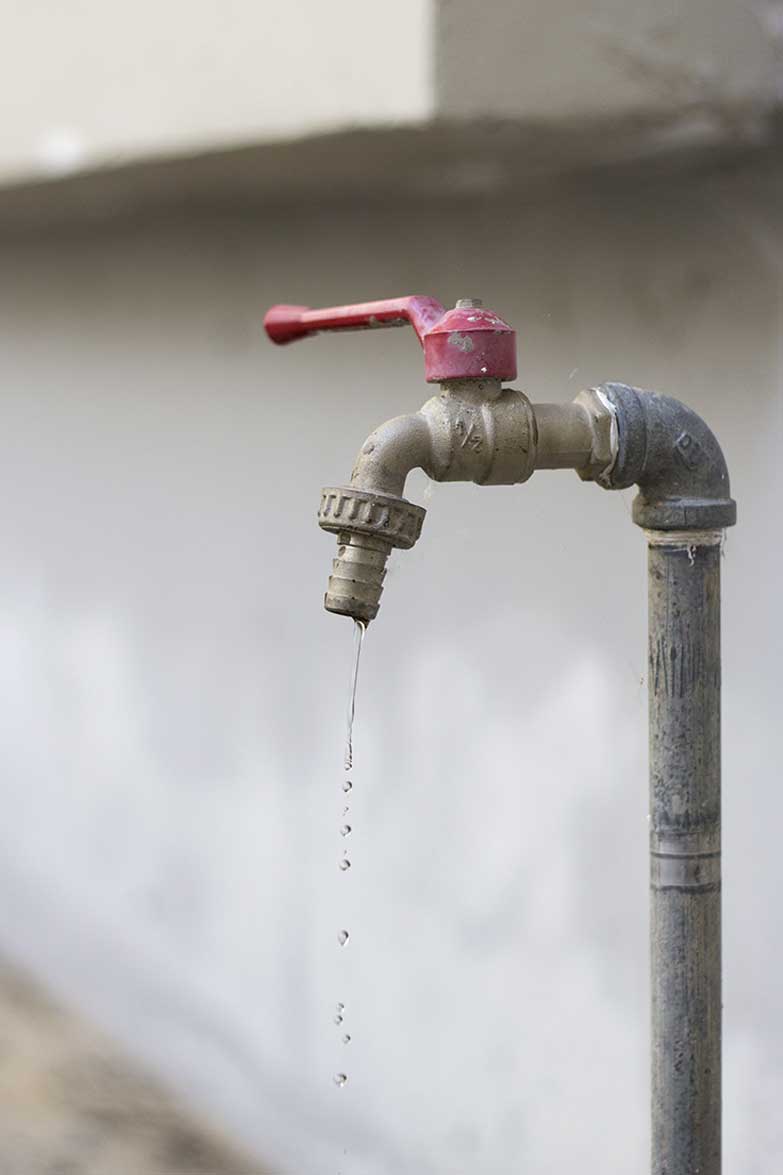
Freshwater is a finite resource. Even seemingly small problems like a leaking faucet must be taken seriously and repaired. Image credit: Shutterstock/kwanhom
Unsustainable vs. Sustainable Landscapes:
How They Compare
Unsustainable Landscape
- Treats stormwater as a waste product that is quickly removed from the site, contributing to water pollution.
- Most irrigation systems use municipal drinking water.
Sustainable Landscape
- Manages stormwater on site. Uses stormwater as a resource to sustain the landscape.
- Minimizes the use of potable water. Supplements water in the landscape with on-site alternatives such as harvested rainwater, stormwater or air conditioner condensate.
GET STARTED WITH WATER
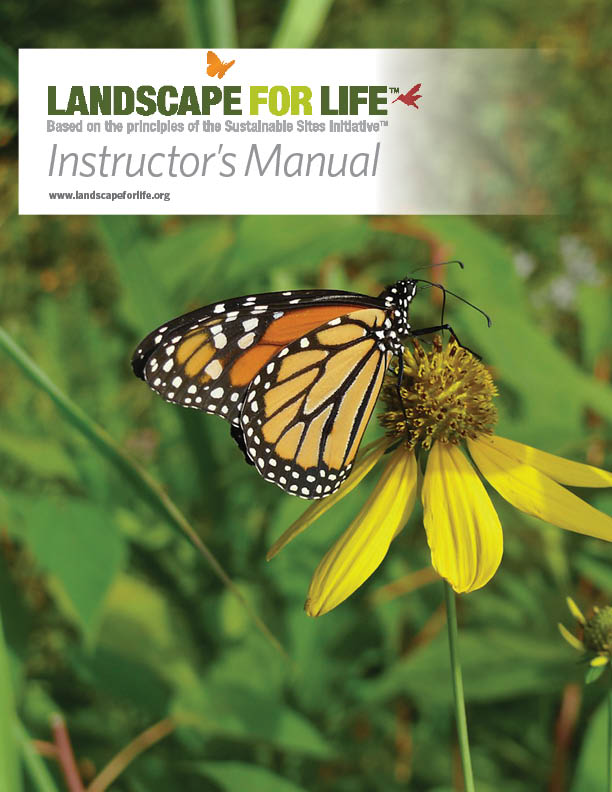
BECOME A LANDSCAPE FOR LIFE TEACHER!
Expanded training opportunities coming in 2024! Landscape For Life includes a complete kit of teaching resources which can be used to conduct classes in sustainable home gardening.
Landscape For Life™ was developed by United States Botanic Garden and the Lady Bird Johnson Wildflower Center, based on the principles of the Sustainable Sites Initiative (SITES®). The program is now a collaboration between Colorado State University Extension and the United States Botanic Garden.


